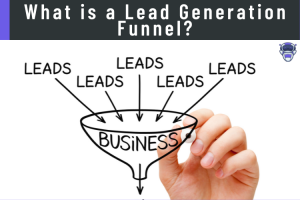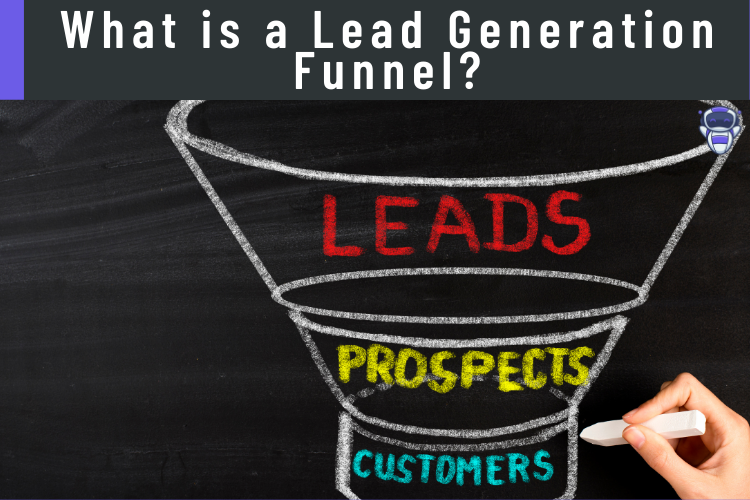A lead generation funnel is a systemic process to generate leads. Today, we’ll talk about the “Lead Generation Funnel” and how it works. Without further ado, we shall start discussing today’s topic.

Contents
- 1 What do we mean by a “Lead Generation Funnel?”
- 2 Let’s discuss the three main stages of the “Lead Generation Funnel”
- 3 Why lead generation funnel is important?
- 4 How do you start a lead generation campaign?
- 5 Establish your objective(s):
- 6 Research your audience:
- 7 Plan your content:
- 8 Create offers:
- 9 Promote your content or offer:
- 10 Optimize your lead capture mechanisms:
- 11 Test the components of your lead generation campaign:
- 12 Perform lead scoring:
- 13 Nurture the leads:
- 14 To Wrap It Up:
What do we mean by a “Lead Generation Funnel?”
When you’re running a business and selling a particular product/service then you would obviously want customers to buy from you. Your product/service can either be very similar to your competitors or very unique.
Let’s assume, your product/service is a common and similar one so why should customers buy from you and not your competitors? How can you make your product stand out?
This is where lead generation comes in. It’s an essential part of the marketing process, turning a potential customer into an actual sale. You will need a “Lead Generation Funnel” to look after the prospects who you want to turn into customers.
It is a process to generate leads. You reach your target audience and guide them to the top of the funnel. From there, you draw them down the funnel until they eventually make a purchase. Lead generation funnels generally have three main stages.
Let’s discuss the three main stages of the “Lead Generation Funnel”
| TOFU (Top of the Funnel) |
| MOFU (Middle of the Funnel) |
| BOFU (Bottom of the Funnel) |
TOFU → Awareness Stage → Buyers don’t yet know about your business and you want to get their attention with this content.
MOFU → Consideration Stage → Buyers are aware of their problem or that something is missing, and they’re considering solutions. This content should explain the problem and possible solutions.
BOFU → Decision Stage → Buyers are ready to pick a solution. This content should convince them that your solution is the best, or make your solution easily available.
The last part of this process is called “Brand Evangelism.” It is after the buyers have made a purchase or plan to make a purchase from your business. Brand evangelism content is designed to strengthen relationships further and improve customer loyalty.
Why lead generation funnel is important?
When you’ll have a well-functioning “Lead Generation Funnel” then it’ll help you determine the correct steps to take in generating awareness and boosting consumers’ interest in your brand.
The stages of the lead generation marketing funnels are solely designed to attract the prospects and push them down into making them the customers who will purchase.
Here are a few of the benefits to lead generation:
- Lead Generation Funnels Generate Awareness
- Lead Generation Funnels Help To Increase Sales and Profit Ratio
- Lead Generation Funnels Build Relationships With Your Target Customers
- A Lead Generation Funnel Can Help To Build Important Data
- Lead Generation Funnels Are Cheaper Than Traditional Advertising
How do you start a lead generation campaign?
- Establish your objective(s)
- Research your audience
- Plan your content
- Create offers
- Promote your content or offer
- Optimize your lead capture mechanisms
- Test the components of your lead generation campaign
- Perform lead scoring
- Nurture the leads
Establish your objective(s):
Set a goal. Figure out “what” and “how” you want to achieve the goal. Find out how many leads you need. What’s your cost-per-lead goal? In what timeframe do you need to be successful?
Some common objectives and goals can be:
- A specific number of leads
- Revenue per lead
- Subscribers
- Registrants
- Trials
- Sales
- Conversion rate
Research your audience:
Try to investigate “who” your objectives are. They can be anyone. They can be online shoppers, can be women, can be seniors, and so on but it’s your expertise that will divide and decide who is good for your business. The more you get to know your prospective buyers, the more your chances are high to narrow down what and who you are relying on for sales.
To understand your prospective buyers the following will get you started:
- Examine the demographics of your website visitors with Google Analytics
- Examine the demographics of your social followers
- Probe the sales team for their take on who buys your products and services
- Try to ascertain what types of buyers your competitors target
- Run surveys
- Conduct customer interviews
Plan your content:
Without content, your business is futile. Always give importance to content. It is a very crucial and significant step to generate leads and turn prospects into customers. The content draws customers toward your business and it gives your business the exposure it needs to run.
Your content may surface on one channel, or many, including your:
- Website
- Blog
- Social media accounts
- Video and/or audio channels
- Other media where you interact with customers
Create offers:
Always give out offers and deals. This method is very interesting to prospects/customers. You can create “Lead Magnets” via these offers/deals.
What will you offer? Essentially, you’ll answer the question, what do you want the person to do? The list is long and often includes:
- Download an information asset
- Register for an event
- Try a product
- Buy a product
- Enter a contest or giveaway
- Watch a video
- Subscribe to a newsletter
- Sign up for a course
- Complete a survey or assessment
- Request a demonstration
- Request a Consultation
- Request a quote
- Get a coupon or discount
Promote your content or offer:
Once you’re done with creating an offer or content, promote them constantly. When you’ll promote them, they will show up on customers’ feeds or in emails.
Now you may ask, how do I promote it?
Some possible channels for promotion include —
- Your own email lists
- Organic social media channels
- Blog posts
Paid advertising in the form of
- Social media
- Native advertising
- Search advertising
- Display advertising
- PPC campaigns
Others
- Guest article and PR activity
- Event activations
Optimize your lead capture mechanisms:
When you introduce a CTA(call-to-action), you think your customers/prospects will react to them but the question is, WILL THEY? It’s when optimizing your lead magnets/lead capture mechanisms steps in.
When you’ll have an optimized lead magnet or lead machine only then it’ll make it easier for your prospects to come in. This means that the mechanisms that feature forms you put in place to capture leads — including landing pages, popups, and chat — must come through for you at an acceptable rate and has to be user-friendly.
Test the components of your lead generation campaign:
When your campaign continues for a reasonable period, you must optimize it along the way. You can do this by closely examining key metrics that reflect the efficacy of each component and running A/B split tests to compare different iterations.
Split testing is the process of testing elements of your campaign by creating variants, including email subject lines, headlines, copy, CTAs, page design, and ad targeting.
Perform lead scoring:
Lead scoring helps your marketing and sales team focus its efforts on the leads most likely to become paying customers. Lead scoring assigns values to the quality of each lead to help sales teams identify when and how to approach the buyer.
There are a variety of lead-scoring models and ways to put them into play. A good model for getting started is to focus on criteria including
- Fit — The degree to which the prospect fits your buyer persona(s)
- Behavior — How the prospect has interacted with your content and brand
- Buying stage — Where the prospect is in your sales funnel
Nurture the leads:
Nurturing the gathered leads guides the potential buyers through the stages of your sales funnel that lead to a sale — and beyond.
‘Beyond’ could mean increased loyalty and retention, additional purchases, and even brand advocacy.
The process of lead nurturing requires providing leads with help, information, content and offers based on their current needs.
The most efficient — and often, effective — lead nurturing process involves sending highly relevant emails and post-purchase care of your leads.
How can you nurture leads?
- Welcome emails
- The delivery of offers
- Helpful problem/solution content
- Solution comparisons
- Case studies
- Making smart purchase decisions
- Getting the most from your product or service
To Wrap It Up:
However, we have discussed the most crucial features and points of how a “Lead Funnel” & “Lead Campaign” works. We hope we were able to provide you with the information you needed and we hope it was helpful to you. There are more articles on various topics, you can check “How To Get Sales Leads For Free?” out! Thanks for reading and being with us.



… [Trackback]
[…] There you will find 4495 additional Information to that Topic: blog.leadstal.com/lead-generation-funnel/ […]
… [Trackback]
[…] Find More to that Topic: blog.leadstal.com/lead-generation-funnel/ […]
… [Trackback]
[…] Read More to that Topic: blog.leadstal.com/lead-generation-funnel/ […]
… [Trackback]
[…] Read More Info here to that Topic: blog.leadstal.com/lead-generation-funnel/ […]
… [Trackback]
[…] There you can find 11771 more Info to that Topic: blog.leadstal.com/lead-generation-funnel/ […]
… [Trackback]
[…] Read More here to that Topic: blog.leadstal.com/lead-generation-funnel/ […]
… [Trackback]
[…] Read More Info here on that Topic: blog.leadstal.com/lead-generation-funnel/ […]
… [Trackback]
[…] Information to that Topic: blog.leadstal.com/lead-generation-funnel/ […]
… [Trackback]
[…] Info on that Topic: blog.leadstal.com/lead-generation-funnel/ […]
… [Trackback]
[…] There you can find 67731 additional Info to that Topic: blog.leadstal.com/lead-generation-funnel/ […]
… [Trackback]
[…] Here you will find 10856 more Info to that Topic: blog.leadstal.com/lead-generation-funnel/ […]
… [Trackback]
[…] Information to that Topic: blog.leadstal.com/lead-generation-funnel/ […]
… [Trackback]
[…] There you will find 76647 more Information to that Topic: blog.leadstal.com/lead-generation-funnel/ […]
… [Trackback]
[…] Find More to that Topic: blog.leadstal.com/lead-generation-funnel/ […]
… [Trackback]
[…] Read More on that Topic: blog.leadstal.com/lead-generation-funnel/ […]